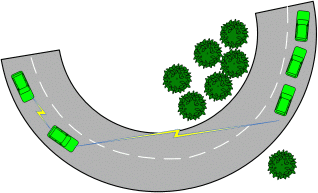Distributed Cooperation of Cognitive Automobiles
- Contact: Dipl.-Inform. Christian Frese
- Project Group: SFB/Transregio 28 Cognitive Automobiles
- Funding:
- Startdate:
2006
- Enddate:
2010
SFB/Transregio 28 Cognitive Automobiles
From 2006 until 2010, researchers from KIT, Technische Universität München, Universität der Bundeswehr München, and Fraunhofer IITB worked together in the Transregional Collaborative Research Center (Sonderforschungsbereich/Transregio) 28 Cognitive Automobiles.
Subproject B3: Distributed Cooperation
 Vision and Fusion Laboratory and Fraunhofer IITB (now IOSB) were in charge of subproject B3 Distributed Cooperation. The main goal of subproject B3 was to increase traffic safety by cooperative behavior of communicating vehicles.
Vision and Fusion Laboratory and Fraunhofer IITB (now IOSB) were in charge of subproject B3 Distributed Cooperation. The main goal of subproject B3 was to increase traffic safety by cooperative behavior of communicating vehicles.
In addition to the information from the car's local perception obtained by sensors such as video and GPS, high-level information is exchanged with other traffic participants via vehicle-to-vehicle communication. This results in more adequate, trustworthy and reliable information on the traffic situation.
Communication-based safety systems can mitigate dangers by a timely warning, for example when approaching the tail end of a traffic jam.
However, exchange of information is not sufficient in many situations. Rather, coordinated and trustworthy behavior of multiple vehicles is required. The latter was be investigated within the subproject B3.

Consider the example of a suddenly appearing obstacle on a multi-lane road. All involved vehicles have to coordinate their maneuvers in order to avoid the obstacle. Otherwise, a collision between some of the vehicles might result. Therefore, the reliable and timely execution of the individual parts of the multi-vehicle maneuver has to be assured.

Overtaking is another important scenario for distributed cooperation. Coordinated braking of the vehicles on the right lane allows the overtaking vehicle to merge earlier, thus reducing the risk of a collision with oncoming traffic.
The first step towards cooperative behavior is the aggregation of all involved vehicles into a cooperative group. For each cooperative group, a common relevant picture will be set up which contains the important information on the current and future traffic situation. Situation recognition and assessment are based on the common relevant picture. Depending on the detected situation, adequate cooperative action decisions for each vehicle are generated, which are executed in a coordinated manner.
Goals of Subproject B3
- Cooperative multi-criteria decisions for exploiting the safety benefit from coordinated actions of multiple cooperative vehicles within a traffic scenario.
- Handling of safety-critical situations which temporarily require coordinated behavior by automated driving actions.
- Formal representation of cooperative groups:
- criteria for join, leaving, formation, split, merging, decomposition,
- representation in a distributed computing envrionment,
- inter-group communication.
- Fusion of all relevant information available to the cooperative group into a common relevant picture which contains
- cooperating vehicles (vehicle state, abilities, missions, intentions),
- relevant non-cooperative vehicles and objects,
- mutual relations,
- relevant environmental conditions.
- Recognition of dangerous situations which cannot be handled by the drivers.
- Planning cooperative maneuvers for collision avoidance and mitigation.
Methods
- Methods for a formal representation of the common relevant picture:
- Ontologies: situation modeling, rule-based inference, situation recognition
- Bayesian networks
- Methods for optimal distributed decisions:
- Cooperative motion planning
- Statistical decision theory
- Agent-based simulation: modeling, simulation and verification using well-defined example scenarios
- Assessment of performance and reliability of the above-mentioned methods
Results
The feasibility of distributed group formation and the cooperative collision avoidance have been shown by means of a traffic simulator. Different algorithms for planning cooperative motions have been compared. In many scenarios, the investigated algorithms are more successful in terms of collision avoidance than state-of-the-art methods such as prioritized motion planning. The cooperative motion planning algorithms show potential for a real-time implementation.
